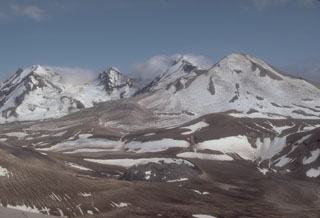Report on Trident (United States) — 22 February-28 February 2023
Smithsonian Institution / US Geological Survey
Weekly Volcanic Activity Report, 22 February-28 February 2023
Managing Editor: Sally Sennert.
Please cite this report as:
Global Volcanism Program, 2023. Report on Trident (United States) (Sennert, S, ed.). Weekly Volcanic Activity Report, 22 February-28 February 2023. Smithsonian Institution and US Geological Survey.
Trident
United States
58.236°N, 155.1°W; summit elev. 1864 m
All times are local (unless otherwise noted)
An earthquake swarm at Trident began on 24 August 2022 and within about four days the seismic network began detecting episodes of weak seismic tremor and low frequency earthquakes. The events were initially located at depths around 25 km, but then they progressively shallowed to around 5 km by 28 August. AVO raised the Aviation Color Code for Trident to Yellow (the second lowest level on a four-color scale) and the Volcano Alert Level to Advisory (the second lowest level on a four-level scale) on 29 September due to an ongoing seismic swarm. AVO attributed the swarm to moving magma or magmatic fluids and noted that seismic swarms had previously been recorded with no subsequent eruptions. The swarm subsided and on 19 October 2022 AVO lowered both the Aviation Color Code and the Volcano Alert Level were lowered to Green and Normal, respectively, and noted that tremor had been absent since 30 September.
Beginning on 1 January 2023 seismicity again increased with earthquakes occurring at an average rate of about ten per day at depths less than 6 km. The elevated seismicity was sustained, prompting AVO raised the Aviation Color Code to Yellow and the Volcano Alert Level to Advisory on 22 February. Dozens of small earthquakes were recorded daily during 23-28 February; the largest event, a M4, was recorded during the morning of 24 February. Trident last erupted during 1953-1974.
Geological Summary. The Trident stratovolcano cluster was named for the three prominent peaks that were the most visible features at the summit prior to 1953. The andesitic-dacitic group consists of four overlapping stratovolcanoes and numerous flank lava domes, including Falling Mountain and Mt. Cerberus on the far west flank. The summit complex is located 3-5 km SE of Novarupta volcano, and merges along a ridge to the NE with Katmai. The three oldest Trident volcanoes are glaciated and Pleistocene in age, while the youngest, Southwest Trident, was formed during historical time. Eruptions migrated through time from the NE to the SW. In 1953 a new lava dome began growing on the SW flank of Trident I volcano. A series of thick andesitic lava flows were erupted between 1953 and 1968, forming a cone with 400-800 m of local relief. Periodic explosions took place until 1974, and the current summit contains a 350-m-wide crater. Some of the distal lava flows from West Trident stratovolcano collapsed into the Novarupta vent during its 1912 eruption.
Source: US Geological Survey Alaska Volcano Observatory (AVO)

